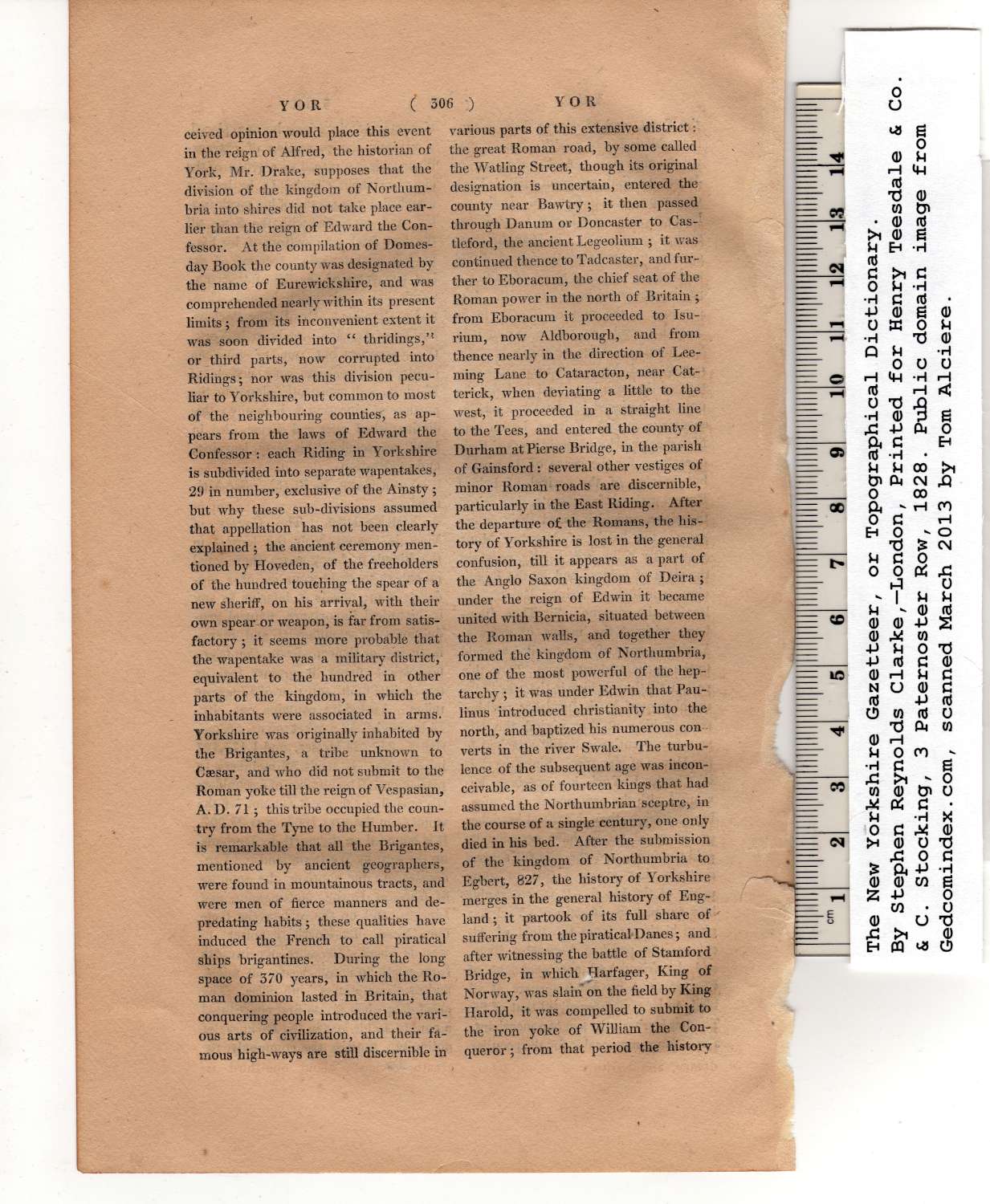|
ceived opinion would place this event
in the reign of Alfred, the historian of
York, Mr. Drake, supposes that the
division of the kingdom of Northum-
bria into shires did not take place ear-
lier than the reign of Edward the Con-
fessor. At the compilation of Domes-
day Book the county was designated by
the name of Eurewickshire, and was
comprehended nearly within its present
limits; from its inconvenient extent it
was soon divided into “ thridings,”
or third parts, now corrupted into
Ridings; nor was this division pecu-
liar to Yorkshire, hut common to most
of the neighbouring counties, as ap-
pears from the laws of Edward the
Confessor : each Riding in Yorkshire
is subdivided into separate wapentakes,
29 in number, exclusive of the Ainsty;
hut why these sub-divisions assumed
that appellation has not been clearly
explained ; the ancient ceremony men-
tioned by Hoveden, of the freeholders
of the hundred touching the spear of a
new sheriff, on his arrival, with their
own spear or weapon, is far from satis-
factory ; it seems more probable that
the wapentake was a military district,
equivalent to the hundred in other
parts of the kingdom, in which the
inhabitants were associated in arms.
Yorkshire was originally inhabited by
the Brigantes, a tribe unknown to
Csesar, and who did not submit to the
Roman yoke till the reign of Vespasian,
A. D. 71; this tribe occupied the coun-
try from the Tyne to the Humber. It
is remarkable that all the Brigantes,
mentioned by ancient geographers,
were found in mountainous tracts, and
were men of fierce manners and de-
predating habits; these qualities have
induced the French to call piratical
ships brigantines. During the long
space of 370 years, in which the Ro-
man dominion lasted in Britain, that
conquering people introduced the vari-
ous arts of civilization, and their fa-
mous high-ways are still discernible in
various parts of this extensive district:
the great Roman road, by some called
the Watling Street, though its original
designation is uncertain, entered the
county near Bawtry; it then passed
through Danum or Doncaster to Cas-
tleford, the ancient Legeolium ; it was
continued thence to Tadcaster, and fur-
ther to Eboracum, the chief seat of the
Roman power in the north of Britain ;
from Eboracum it proceeded to Isu-
rium, now Aldborough, and from
thence nearly in the direction of Lee-
ming Lane to Cataracton, near Cat-
terick, when deviating a little to the
west, it proceeded in a straight line
to the Tees, and entered the county of
Durham at Pierse Bridge, in the parish
of Gainsford: several other vestiges of
minor Roman roads are discernible,
particularly in the East Riding. After
the departure of the Romans, the his-
tory of Yorkshire is lost in the general
confusion, till it appears as a part of
the Anglo Saxon kingdom of Deira;
under the reign of Edwin it became
united with Bernicia, situated between
the Roman walls, and together they
formed the kingdom of Northumbria,
one of the most powerful of the hep-
tarchy ; it was under Edwin that Pau-
linus introduced Christianity into the
north, and baptized his numerous con
verts in the river Swale. The turbu-
lence of the subsequent age was incon-
ceivable, as of fourteen kings that had
assumed the Northumbrian sceptre, in
the course of a single century, one only
died in his bed. After the submission
of the kingdom of Northumbria to
Egbert, 827, the history of Yorkshire
merges in the general history of Eng-
land ; it partook of its full share of
suffering from the piratical Danes; and
after witnessing the battle of Stamford
Bridge, in which Harfager, King of
Norway, wras slain on the field by King
Harold, it was compelled to submit to
the iron yoke of William the Con-
queror; from that period the history |
